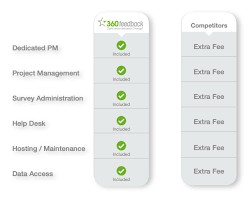In the dynamic landscape of organizational development, the conventional methods of employee performance evaluation are evolving. At the forefront of this evolution is the transformative power of 360 feedback surveys. This article delves into the multifaceted benefits of 360 surveys, unveiling how they transcend traditional approaches, providing organizations with a holistic understanding of their workforce. As we explore the depth of this transformative tool, it becomes evident that 360-degree surveys are not merely an evaluation method; they are a catalyst for fostering continuous improvement and enriching employee engagement.
Understanding the Essence of 360 Surveys
Shifting from Traditional to Comprehensive Evaluation:
360-degree surveys mark a departure from the traditional top-down evaluation model. Rather than relying solely on managerial assessments, these surveys embrace a 360-degree approach by collecting feedback from multiple sources – peers, subordinates, and even self-assessment. This shift ensures a more comprehensive and nuanced understanding of an individual's performance.A Comprehensive View of Strengths and Areas for Improvement:
Traditional evaluations may spotlight certain strengths or weaknesses, often missing the intricacies of an employee's contribution. 360 surveys, on the other hand, provide a comprehensive view, revealing both unnoticed strengths and areas for improvement. This holistic perspective becomes a strategic asset in talent development and organizational growth.
Uncovering the Benefits of 360 Surveys
Fostering a Culture of Continuous Improvement:
One of the defining features of 360 feedback for manager is their capacity to cultivate a culture of continuous improvement. By soliciting feedback from diverse sources, organizations create an environment where employees actively seek opportunities to enhance their skills and performance. The emphasis shifts from periodic assessments to an ongoing journey of development.Elevating Employee Engagement:
Employee engagement stands as a cornerstone of organizational success. 360-degree surveys play a pivotal role in elevating engagement levels by involving employees in the evaluation process. When individuals feel that their opinions are valued, it contributes to a sense of ownership, job satisfaction, and a positive impact on overall workplace culture.Tailored Development Plans for Professional Growth:
The insights garnered from 360-degree surveys empower organizations to craft tailored development plans for individual employees. Unlike generic development initiatives, these plans address specific areas highlighted by the feedback, ensuring a targeted and impactful approach to professional growth.Strategic Talent Management:
The strategic aspect of 360-degree surveys becomes apparent in talent management. Organizations can identify high-potential individuals and tailor development plans to harness their capabilities fully. This approach not only nurtures talent but also aligns individual growth with the broader goals of the organization.
Implementation and Maximizing Effectiveness
Ensuring Confidentiality and Building Trust:
The success of 360 surveys hinges on the assurance of confidentiality. Employees may hesitate to provide candid feedback if they fear repercussions. Robust measures ensuring confidentiality and transparent communication build trust, creating an environment conducive to open and honest feedback.Effectively Communicating Survey Results:
The effectiveness of 360-degree surveys is closely tied to how well the results are communicated. Transparent communication channels, feedback sessions, and guidance on interpreting results are crucial to ensure that employees understand the purpose of the survey and its role in their individual development and the broader organizational strategy.
Overcoming Challenges and Driving Adoption
Engaging Leadership and Stakeholders:
Resistance to change is a common challenge when introducing new evaluation methods. Engaging leadership and stakeholders at every level is crucial. When leaders actively endorse the benefits of 360 surveys and participate in the process, it sets the tone for widespread adoption throughout the organization.Providing Training and Support:
Successful implementation necessitates training and support for both employees and managers. Offering resources, workshops, and guidance on navigating the survey process ensures that everyone involved comprehends the significance of the tool and feels equipped to participate effectively.
Conclusion
360 feedback assessment represent more than just an evaluation tool – they signify a transformative journey towards organizational excellence. Their impact extends far beyond traditional methods, creating a culture of continuous improvement and heightened employee engagement. As organizations navigate the complexities of the modern workplace, embracing the transformative influence of 360-degree surveys becomes not only a strategic choice but a commitment to unlocking the full potential of the workforce. For those curious about elevating their organization's performance evaluation strategies, the insights shared in this must-watch video present a compelling invitation to embark on the transformative journey that 360-degree surveys offer.








